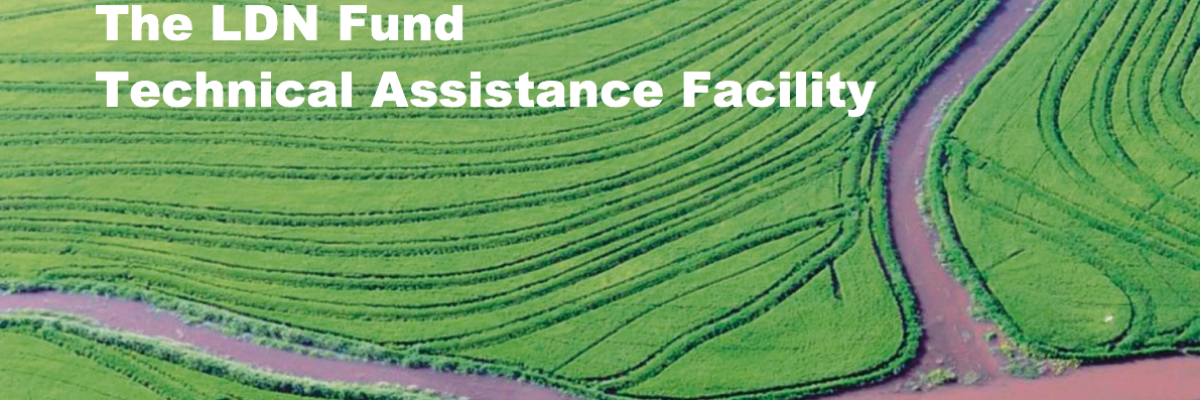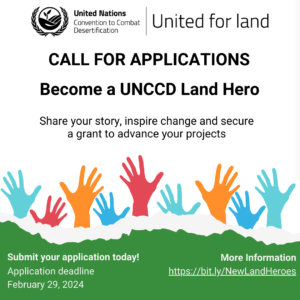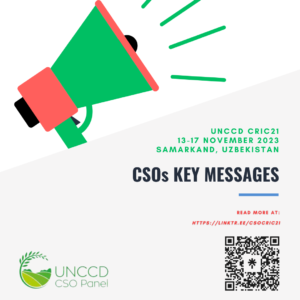CSO Synthesis of the Global Mechanism Report on the Update on the 0perationalization of the Land Degradation Neutrality Fund (LDN Fund).
Document ICCD/CRIC(19)/3) to be revised at the 19th session of the Committee for the Review of the Implementation of the Convention (CRIC).
____________________
- Overview and introduction of Land Degradation Neutrality Fund
UNCCD COP14 (decisions 13 &14) decided that the LDN Fund provides regular updates on its operations, selection of projects, priorities, and along with Global Mechanism (GM), provide support and capacity-building for accessing the LDN Fund. It is also requests the GM to submit a report on the operations of the LDN Fund at CRIC19.
The LDN Fund promoted by the UN Convention to Combat Desertification (UNCCD) and spearheaded by Global Mechanism (GM) and the investment management firm Mirova, LDN Fund was established based on decision 3/COP.12, and in conjunction with decisions 18/COP.12 and 18/COP.11 on 12 September 2017 at the COP13 in Ordos, China.
The Fund’s mission is to be a source of transformative capital, pooling resources from both public and private investors committed to the goal of stopping land degradation to fund triple bottom line projects, contributing to the 2030 Sustainable Development Goals (SDGs) (target 15.3).
- Background information on operationalization of the Land Degradation Neutrality Fund
LDN Fund has been initially financed by the governments of France, Luxembourg and Norway, and the Rockefeller Foundation and involvement of an advisory group that brought together representatives from public financial institutions, international NGOs and academia.
The French investment management firm Mirova, an affiliate of Natixis Investment Managers was chosen as a co-promoter to develop structure and implement the LDN Fund as a result of the call for expression of interest published by the GM in July 2015.
Sustainable Trade Initiative (IDH), which has expertise in smallholder agriculture, supply chains and innovative finance, has been chosen as the partner to develop and manage the Technical Assistance Facility (TAF) through a process of competitive tendering.
GM is now mainly focused on linking country Parties and project developers with the managers of the LDN Fund and the TAF.
The Executive Secretary of the UNCCD serves as a Chair of the advisory Strategic Board of the LDN Fund and the TAF, which also comprises the heads of the Rio Conventions, to provide strategic guidance to the managers of the LDN Fund and the TAF in line with the objectives of the three Rio Conventions.
As of October 2020, the LDN Fund has secured over USD 170 million in commitments from a wide range of public and private investors, with USD 140 million currently deployable. The report also lists the names of all the public investors.
- Operations of the Land Degradation Neutrality Fund
The Fund invests in profit-generating sustainable land management and land restoration projects worldwide, to contribute to a land degradation neutral world. Fund will invest mainly in countries that have made a national voluntary LDN commitment, but this commitment is not required for an investment to be considered.
Potential projects must be land-based projects that can avoid, reduce or reverse land degradation while producing financial returns. The projects must comply with the Fund’s investment criteria – the projects should demonstrate their contribution to LDN, benefit local communities and ecosystems, and comply with robust environmental and social standards.
The Fund provides long-term financing (debt/equity) to projects that meet strict environmental and social standards.
- Environmental and social management system (ESMS) was developed to ensure projects run in compliance with the International Finance Corporation (IFC) Performance Standards and the IFC Environmental, Health, Safety Guidelines. The LDN Fund follows the Voluntary Guidelines on the Governance of Tenure (VGGT) of Land Fisheries and Forests and the United Nations Guiding Principles on Business and Human Rights. The Fund also complies with national environmental, social and labour laws and legislation, including the International Labour Organization’s Core Conventions, and with any environmental, social, and corporate governance requirements of investors in the Fund. The ESMS also includes a complaint and compliance mechanism to ensure that project-affected populations have formal ways to voice their concerns and identify and correct the causes for grievance.
TAF and IDH support LDN project developers and facilitate project preparation.
As of the second quarter of 2020, the LDN Fund has invested in four land restoration projects. The fifth project, in Nicaragua, is also about to be signed.
- Urapi Sustainable Land Use: implementation of agroforestry systems and development of sustainable production in certified organic and fair-trade coffee sectors in Colombia and Peru.
- Mountain Hazelnut production: restoration of degraded land through sustainable orchards and production development in the hazelnut sector in Bhutan.
- Miro Forestry plantation: expansion of large-scale reforestation activities in Ghana and Sierra Leone through the timber sector.
- Komaza project: The goal of the Komaza project in Kenya is to support Komaza in planting one billion trees by 2030.
- Conclusions
Before CRIC19, Mirova and IDH will share a publication with more insights and lessons learned from the first two years of operations of the LDN Fund and the TAF.
The project portfolios managed by Mirova and IDH are growing, resulting in the promotion of land as a new asset class among the investors. Furthermore, the LDN Fund initiative is promoting the use of the LDN framework and indicator at the project level.
Project developers can submit the proposals directly to the LDN Fund investment team at Mirova by sending a short summary of the project aims, current status and financing needs to the official email account ([email protected])
The LDN Fund is receiving increased global attention, as seen at the One Planet Summit describing the LDN Fund as 1 of the 12 global initiatives that will be supported under the Summit.
CSOs Comments:
The CSOs welcome the LDN Fund to target positive impacts in climate, biodiversity, fight against poverty, promote gender equality, and admire its operations according to robust environmental and social standards. However, the Updated report doesn’t provide details on how LDN Fund projects meet the impact criteria and how they benefit local natural ecosystems.
CSOs are concerned about expanding large-scale reforestation activities in Ghana and Sierra Leone through the timber sector. The planted trees include introduced species as a monoculture plantation within a natural ecosystem. It is likely, that one of the introduced planted tree species has negative impacts on the ecology, lowering groundwater tables, destroys biodiversity, and negatively impacts the natural ecosystem. (Zhang, Dj., Zhang, J., Yang, Wq. et al. Potential allelopathic effect of Eucalyptus grandis across a range of plantation ages. Ecol Res 25, 13–23 (2010).)
CSOs would like to access enough information whether the standards that apply to the projects are balanced and appropriate concerning the people that are involved in the project and whether they adequately consider the local context;
Civil Society Organizations including indigenous peoples and local community organizations, would like for direct involvements in the projects and receive support for capacity building, design, implementation, and evaluation of small-scale projects as a complementary component of the Fund;
CSOs would like to access the detailed information flow through a website or database to show how the projects are functioning and how local communities/organizations are involved in the design, implementation, and evaluation processes of the projects;
In this context, CSOs would like to access positive examples of investments as inspirational for the LDNF and would like to raise the following questions for clarifications:
Questions for clarification:
- How do the LDN Fund projects concretely contribute to achieving LDN, meet the Impact criteria, and adequately benefit local ecosystems and local communities of land users?
- How much public money was spent on the LDN Fund projects?
- What is the before and after the status of the degraded lands?
- How does the LDN Fund follow the Voluntary Guidelines on the Governance of Tenure?
- How does the LDN Fund guarantee meaningful participation of local people in decision- making processes and FPIC?
- What are the requirements for the project proposals?
- How do the LDN Fund projects consider women’s rights in large-scale projects?
- Are the LDN Fund’s ambitions overrated and unrealistic?
- What has the LDN Fund learned, and how could this knowledge be shared with the CSOs and other stakeholders?
- What are the checks and balances to guarantee that LDNF projects will support LDN?
- What kind of positive examples of investments does the Fund see as inspirational for the LDNF?






